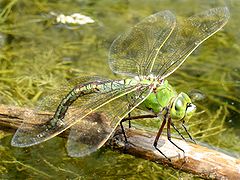Emperor dragonfly
| Emperor dragonfly | |
|---|---|

| |
| Male Puerto de la Cruz, Tenerife | |

| |
| female Whitecross Green Wood, Oxfordshire | |
| Scientific classification | |
| Domain: | Eukaryota |
| Kingdom: | Animalia |
| Phylum: | Arthropoda |
| Class: | Insecta |
| Order: | Odonata |
| Infraorder: | Anisoptera |
| Family: | Aeshnidae |
| Genus: | Anax |
| Species: | A. imperator
|
| Binomial name | |
| Anax imperator Leach, 1815
| |
| Synonyms[1] | |
| |
The emperor dragonfly[2] or blue emperor[1] (Anax imperator) is a large species of hawker dragonfly of the family Aeshnidae, averaging 78 millimetres (3.1 in) in length.[2] The generic name Anax is from the ancient Greek ἄναξ, "lord";[3] the specific epithet imperator is the Latin for "emperor", from imperare, to command.[4]
Distribution
This dragonfly has a wide distribution; it is found throughout Africa and through most of Europe, the Arabian Peninsula, and south-western and central Asia.[1] Since 2000, its range has expanded in Europe, both northwards and to higher altitudes.[1][5]
Behaviour
They frequently fly high up into the sky in search of prey, which includes butterflies, other Odonata and tadpoles; small prey is eaten while flying. They breed in a variety of aquatic habitats from large ponds to dikes, but they require a plentiful supply of vegetation in the water. The females lay the eggs into plants such as pondweed, and always lay alone. The larvae are very aggressive and are likely to influence the native species composition of colonized freshwater ecosystems.[5] The adult male is highly territorial, and difficult to approach.[6] In the summer months emperor dragonflies are frequent visitors to gardens, being especially prevalent in the southern counties of Great Britain.
Identification
When they first emerge, both sexes appear pale green with brown markings. The legs are brown with a yellow like base. Wings are born black but grow yellow-brown when they grow. Males have a sky blue abdomen marked with a diagnostic black dorsal stripe and an apple green thorax. The thorax and head of a male is green and their prominent eyes are blue. Females have similar markings but they are mainly green.[6]
-
Male
-
Male in side view
-
In flight
-
Laying eggs
-
Emerging
References
- ^ a b c d e Mitra, A. (2016). "Anax imperator". IUCN Red List of Threatened Species. 2016: e.T59812A72311295. doi:10.2305/IUCN.UK.2016-3.RLTS.T59812A72311295.en. Retrieved 19 November 2021.
- ^ a b "Emperor". British Dragonfly Society. Retrieved 25 August 2010.
- ^ Beekes, Robert (2010) [2009]. "S.v. ἄναξ". Etymological Dictionary of Greek. Vol. 1. With the assistance of Lucien van Beek. Leiden, Boston: Brill. pp. 98–99. ISBN 978-900417-418-4.
- ^ "imperator (n.)". Online Etymology Dictionary. Retrieved 27 August 2021.
- ^ a b Herzog, Rebecca; Osigus, Hans − Jürgen; Feindt, Wiebke; Schierwater, Bernd; Hadrys, Heike (29 October 2016). "The complete mitochondrial genome of the emperor dragonfly LEACH, 1815 (Odonata : Aeshnidae) via NGS sequencing". Mitochondrial DNA Part B. 1 (1): 783–786. doi:10.1080/23802359.2016.1186523. PMC 7799497. PMID 33473626.
- ^ a b "Emperor dragonfly videos, photos and facts — Anax imperator". ARKive. Archived from the original on 2015-04-09. Retrieved 2013-08-08.
External links
- Blue Emperor - OdonataMAP - Atlas of African Odonata
 Media related to Anax imperator at Wikimedia Commons
Media related to Anax imperator at Wikimedia Commons Data related to Anax imperator at Wikispecies
Data related to Anax imperator at Wikispecies







